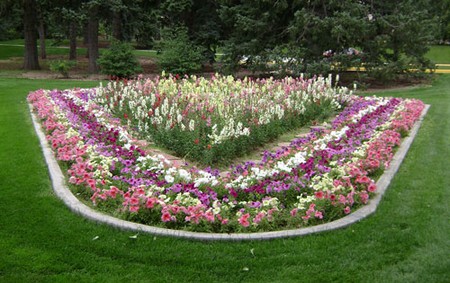I had a triangular plot of my own once and it certainly needed careful planning in order to make the most of the rather limited space. This particular layout would be quite suitable for a family with children. It would also suit someone who prefers the emphasis to be on ornamental planting, low maintenance and only minimal food production.
There is a reasonably large patio, mainly in the sun at the back of the house but, in this instance, it is slightly raised above the level of the garden, necessitating a shallow step down onto the lawn. The bottom step is flush with the lawn for easy mowing and a mowing strip all around the curve would ensure that the mower could reach every blade of grass, leaving a neat and tidy lawn after each mowing. The curves in the patio mean that the paving materials would have to be chosen carefully. Consult with paving contractors if you’re unsure what materials to go for and would like some guidance. Square or rectangular slabs would be difficult to use because of all the curved cutting. Smaller units like bricks or block paviors are a better option but would need a continuous brick edging to finish off all the cut edges. Any brick edge which is perched around the outside of a raised patio needs to be 215 mm (9 in) wide for stability — a 105 mm edge would ‘kick out’ too readily. Crazy paving edged in brick is another possibility. You may also hire an asphalt paving contractor to build a pathway from your home to the garden.

You would enter the garden under a horizontal, wooden beam arch. Although its angle may look odd on the plan, it would, in practice, fit well with the rest of the scheme. To the left of the arch a trellis panel helps to separate this side garden area from the main garden and screens a compost bin together with a few vegetables.
It is often a good idea to have a seat somewhere in the garden. In this example, the seat is likely to be in the shade for some of the day, offering relief from the hot sunshine on the patio. It also provides another viewing point for the garden as well as being an attractive feature in its own right. If the house wall was not planted with some climbers it would appear very stark from this seat and, wherever possible, I always try to soften house walls with planting.
As the lawn narrows into a path which eventually leads to an arch, it will become increasingly susceptible to wear and tear. Some or all of the narrow part could be paved rather than grassed: I have made the change beneath the arch. The arch itself could be almost any style but I would envisage a rustic pole construction with a horizontal top. Once climbing plants have covered an arch its shape and construction become less obvious anyway. Behind the shed is a small area which, although in quite a lot of shade, could accommodate a few soft fruit bushes, an incinerator or compost bins. A cultivated blackberry might succeed on the fence.
In a relatively small garden like this, climbing plants are the best way to disguise the fences rather than bulky shrubs. This will leave space in the borders for plenty of variety — annuals, herbaceous flowers, roses etc. The area beneath any trees will become rather dry and shrubs, including some evergreens, would be more suitable here. If extra space was needed for more planting, a circular bed could replace some of the lawn in the curved area by the patio. The bed could be drawn from the same circle centre which had been used to create the curve of the patio.
The back of the house faces almost due south and, therefore, offers the opportunity to try some of the more exotic climbing plants. It would probably be wise to avoid clematis since the roots would be rather exposed to hot sunshine, something which these plants detest. If a greenhouse were to be added, the most likely spot would be the area at the side of the house where the trellis screen and a few vegetables are at the moment. Alternatively, the shed could be moved right up into the top corner and the greenhouse sited between it and the rustic archway. Neither position would be in full sun all day but, for many greenhouse crops, this would not matter. It is worth considering however, that these projects could mean having to dig and move a lot of dirt. Look for dumpster rental services to make this task much simpler for yourself.
Sometimes, in small gardens like this, one or both of the fences are very low or merely in chain link, offering little or no privacy. To help counter this, trellis panels up to 1.8 m (6 ft) high can be erected at various points and planted with climbers, especially where an instant source of privacy is needed. In other places, where borders are wide, an arrangement of shrubs will eventually provide some privacy.